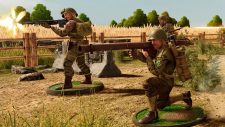Full Spectrum Dominance
Review: Solid Rules Supported by 3D Miniature Files
January 17, 2025 by schoon
Related Review Types
Supported by (Turn Off)
Supported by (Turn Off)
Game: Full Spectrum Dominance
Publisher: The Lazy Forger
Genre: Miniature Wargame Rules
Full Spectrum Dominance is a "combined arms wargame for small scales." What that means is that you have all the mechanics, units, and other elements you need for combined arms warfare in about 40 pages of rules. It's print and play for the rulebook, cards, and miniatures. For the TLDR among you, it's a simple but not simplistic set of rules and well worth checking out, especially with its low price point and excellent miniature designs.
1. SCOPE & SCALE
The game is designed for forces of about 8-12 units, where each unit is a single Rig, vehicle, or small grouping of infantry bases. It can be easily adapted to almost any miniature scale, though 3mm to 15mm is recommended. Since all measurements are made in "Distance Units," 1 DU can be any length appropriate to your miniature scale. The default scale of 6mm miniatures uses a DY of 3 inches. I've found that 1 DU = 4 inches works very well with 10mm minis - my chosen scale. This allows you to not only adapt to your miniature scale, but also your table size. Handy if you only have a kitchen or dining room table to use for an evening's game. While the game scales upwards to larger games (more units) very easily, it doesn't work as well with very small games (fewer than 4-6 units).
2. BASE MECHANIC
The basic combat mechanic: roll a number of dice for the attacking weapon against a target number based on the unit being attacked. Any rolls above the target result in a hit. The defender then rolls a number of armor dice to save against each hit, needing to roll above the attacker's hit die result. There are modifiers and exceptions with certain special rules, such as Armor Piercing, but that's the core. This works quite well in practice and keeps the game moving quickly, but it isn't really what makes the game special.
3. ACTIVATION DICE
The FSD rules really shine in their Activation Dice mechanic. This represent the focus on an area of the battlefield or group of units key to an objective. Each player has a set number of these dice, based on the point value of the forces involved. Activation Dice can be spent to activate a unit and/or use a unit's special abilities. And there are never enough of them to do everything you'd like, so you need to prioritize what units to activate and what abilities you use. At the beginning of each turn you roll a number of these dice, typically 4 less than the total number available. Some of these dice park on your unit cards to allow reactions or readied abilities, so you may end up rolling fewer than the maximum allowed.
Since different unit abilities use specific numbers, such as using a 6 result to activate a heavy weapon or a 1-2 for a defensive ability, this can influence list building, picking units that need different results to use their abilities instead of hoping for a statistically improbable roll of all 6s or 1s.
4. UNIT CARDS
All of the statistics you need to play, and some rules reminders, reside on unit cards. Again, each unit is either a single vehicle, rig, or small group of infantry bases. These cards also keep track of damage for bigger units and are convenient places to track activation status and prepared actions/reactions. Many scenarios use forces that deploy on later turns, so they're also good for tracking which units arrive in which wave. They're a great visual tool to keep track of your forces. The only drawback is that forces that use multiple instances of the same unit don't have a good means of differentiating between the cards and units on the table. There are also "Behemoth" units that have multiple cards that combine to make one huge vehicle/unit. Behemoths are for larger, more advanced scenarios.
5. MINIATURES
The system is miniature agnostic, so you can use whatever miniatures you have at hand, though this will take a bit of work to generate the statistics/cards for non-FSD figures. That said, the FSD miniatures are so well done - with factions that cater to almost any play style - and so well detailed that it's hard to think of reasons not to use them. They are sold as STL files for 3D printing, though you can also obtain them through licensed printers if you don't have a 3D printer of your own. While the default scale is 6mm, you can easily print from 3-15mm. I've chosen 10mm to give me a little more painting real estate for details and decals and am quite happy with the results. Whether you have a printer or buy from someone who does, the cost of a force is much less than the buy in for many other miniature games. You can pick up a 60 point force (which is the standard game size) for about $25-30. Two forces plus the rules is only about $70.
6. FUTURE
Full Spectrum Dominance has had a crowd funding campaign each year since 2022: the first for the rules and two factions; the second for two more factions and and terrain/objectives; and the third for two additional factions and modular building terrain.
Future game development include: solo mode, against dice-automated opponents of animals (crab-like lifeforms) or robots; a hardback printed rulebook by Modiphius; and more future factions and terrain. They have a very active Discord group and the developers are open to ideas from the community.
7. CONCLUSION
Full Spectrum Dominance is an innovative and fun rule set that plays quickly and is supported by an expanding range of well detailed miniatures for 3D printing. The Activation Dice mechanic and out-of-sequence Reactions keep both players engaged regardless of which player is currently activating a unit. It may not be the right choice for those looking for either a small skirmish game or super granular/detailed rule set. At about $10 for the rules & cards, it's worth exploring to see if it's right for you.












































